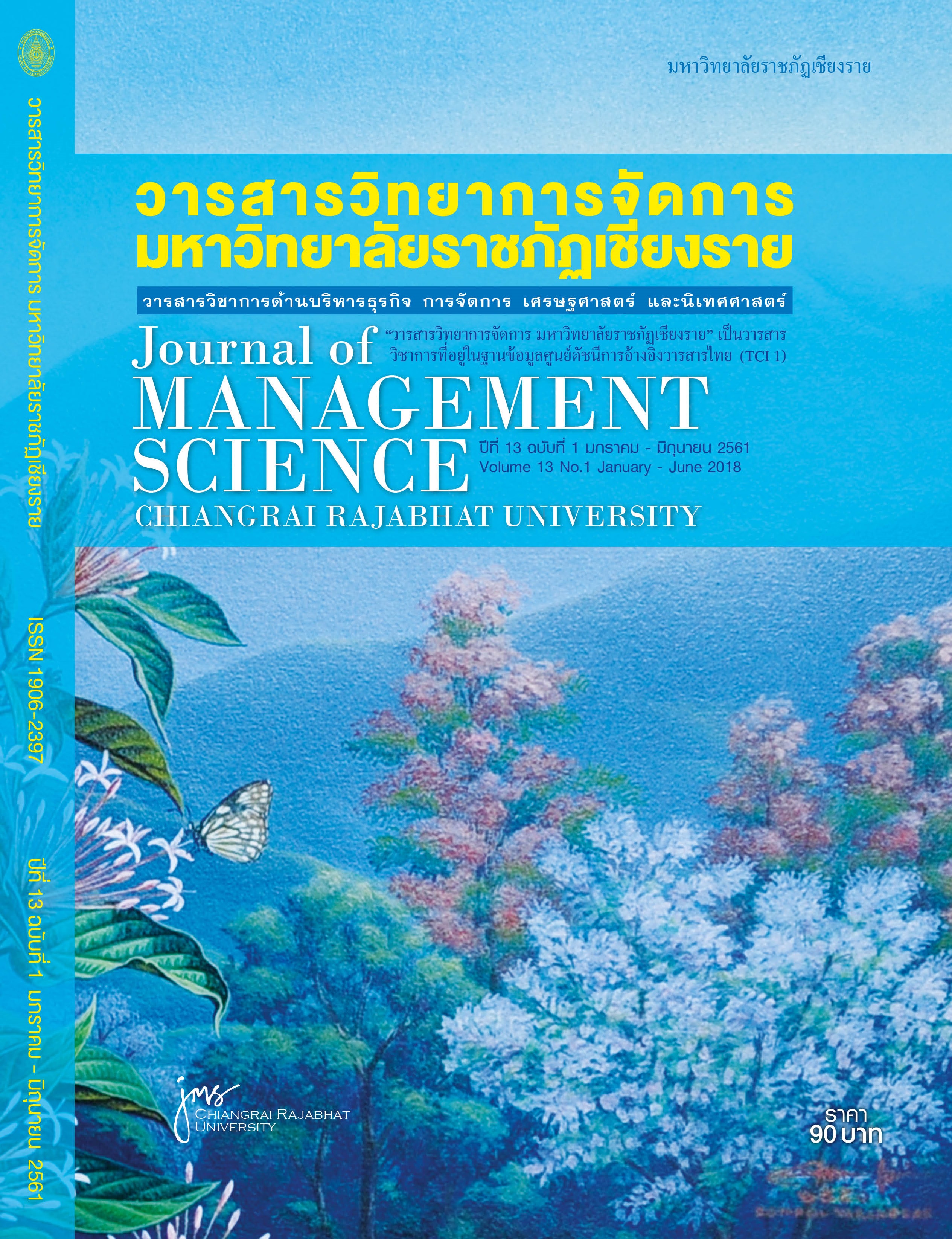Economic Efficiency and Paybacks Period of Longan Growing in Chiang Mai Province
Main Article Content
Abstract
This Research aimed to study the general economic profile, the production efficiency and the payback period of longan growing including challenges and obstacles of longan orchard farmers in Chiang Mai province. Questionnaires were used to gather data from stratified-random-sampling 400 households as the subject population. Longan production efficiency was analyzed by the stochastic production frontier analysis using maximum likelihood for value estimation by equation form of Cobb-Douglas production function. Payback period of longan was estimated based on net present value (NPV), internal rate of return (IRR), benefit-cost ratio (B/C ratio), and payback period.
Results from the longan farmers’ general economic information showed that most of the farmers had 11-20 years of experience in longan farming, owned less than 10 rais of longan farm, were doing a seasonal longan farming, were using Edow longan in their farming, were using loans from the Bank for Agriculture and Agricultural Cooperatives as their investment fund, and were getting gathered to form groups of longan farmers from the same farming areas.
Studies on production efficiency showed the relations between the ages of longan trees, growing area, and production labor used to be in the same direction with an amount of longan produce at statistical significant level 0.01. As for technical efficiency on longan productivity of sample population was 0.6956, with the maximum value and the minimum value of 0.9645 and 0.0465, respectively. The majority 60.50 percent of the sample group expressed medium level of technical production efficiency, with values between 0.50 – 0.80. The study result on factors affecting the technical production inefficiency of longan suggested that GAP certificate acquisition and longan production training enrollment have an impact on the technical production inefficiency of longan in Chiang Mai with the statistical significant level 0.01.
The Research result on the payback period has shown 10.43 percent on the internal rate on return (IRR), with benefit-cost ratio 1.11, and payback period at 7.31 years on approximate. According to the financial analysis made, it is reasonably to conclude that the longan production in Chiang Mai is worthy for investments. On challenges and obstacles in longan production were found to be longan’s pest insects and plant pathogens (56.00%), high price on chemical nutrients (72.50%) and insecticides (69.25%), low price on longan produce (65.00%), and middle man’s hard bargain (57.50%).
Article Details
Views and opinions expressed in the journal do not necessarily reflect those of the editors.
References
Chaimanee, Monsicha. (2548). Cost and Returns of Longan Growing at Amphoe Mae Wang, Chiang Mai Province. (Master of Business Administration). Chiang Mai University, Chiang Mai.
Chiang, S.F ; Sun, H.C. and Yu, M.J. (2004). Technical Efficiency Analysis of milkfish (Chanos Chanos) Production in Taiwan-An Application of the Stochastic Frontier Production Function. Aquaculture, 230, 99-116.
Chiangmai Provincial Agricultural Extension Office. (2016). Agricultural Statistics of Chiangmai Province 2013. Retrieved January 5, 2016, from https://www.chiangmai.doae.go.th/Stat_Plan.html.
Hasnah ; Fleming, E. And Coelli, T. (2004). Assessing The Performance of A Nucleus Estate and Smallholder Scheme for Oil palm Production in West Sumatra : A Stochastic Frontier Analysis. Agricultural Systems, 79, 17-30.
Huang, C.J. and F.S. Bagi. (1984). Technical Efficiency on individual farms in northwest India. Southern Economic Journal, 51, 108-115.
Meunkaew, Jariya. (2553). Comparison of cost and Return between the On-season and Off-season for Longan in Pasang District, Lamphun Province. (Master of Accounting). Chiang Mai University, Chiang Mai.
National Statistical Office. (2016). Number of Population. Retrieved January 5, 2016, from https://statbbi.nso.go.th/
staticreport/page/sector/th/01.aspx.
Office of Agricultural Economics. (2016). Agricultural Statistics of Thailand 2013. Retrieved January 5, 2016, from https://www.oae.go.th/download/download_journal/yearbook56.pdf
Office of Agricultural Economics. (2016). Agricultural Statistics of Thailand 2014. Retrieved January 5, 2016, from https://www.oae.go.th/download/download_journal/2558/yearbook57.pdf
Phummuong, Jutarat. (2545). Technical Efficiency of Soybean Production in the Rainfed Area of Lower Northern Region, Thailand. (Master of Agricultural Economics). Chiang Mai University, Chiang Mai.
Taro Yamane. (1973). Statistic: Introduction Analysis and ed.. Harper International Edition, Tokyo.


